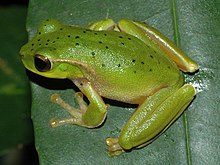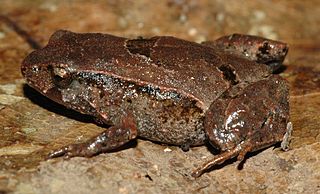
The pouched frog, or hip pocket frog, is a small, terrestrial frog found in rainforests in mountain areas of south-eastern Queensland and northern New South Wales, Australia. It is the sole species within the genus Assa, and is part of the family Myobatrachidae.

Ranoidea chloris, commonly known as the red-eyed tree frog or orange-eyed tree frog, is a species of tree frog native to eastern Australia; ranging from north of Sydney to Proserpine in mid-northern Queensland.

Tyler's tree frog or the southern laughing tree frog is an arboreal tree frog. It is native to eastern Australia. It occurs from southeast Queensland to the south coast of New South Wales. It is generally a coastal species and is not found inland.
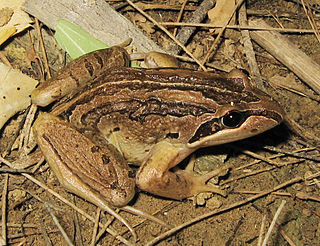
The striped marsh frog or brown-striped frog is a predominantly aquatic frog native to coastal Eastern Australia. It is a common species in urban habitats.
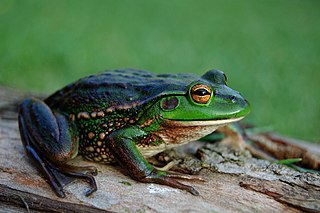
The growling grass frog, also commonly known as the southern bell frog, warty swamp frog and erroneously as the green frog, is a species of ground-dwelling tree frog native to southeastern Australia, ranging from southern South Australia along the Murray River though Victoria to New South Wales, with populations through Tasmania. This species' common names vary between states; the name southern bell frog applies to New South Wales, growling grass frog in Victoria and South Australia, and green and gold frog in Tasmania. This species has been introduced to New Zealand.

The Blue Mountains tree frog is a species of tree frog native to the coastal and highland areas of eastern Australia, from just south of Newcastle NSW, to eastern VIC. The Jenolan Caves tree frog, a population formerly separated as Litoria jenolanensis, is nowadays included in this species.

The southern leaf green tree frog is a species of tree frog native to coastal areas and the ranges of south-eastern Australia. It is distributed from just south of Sydney to eastern Victoria.

The leaf green tree frog is a species of stream-dwelling frog, native to eastern Australia from the Queensland/New South Wales border south to Sydney.

The southern brown tree frog, also known as the brown tree frog, whistling tree frog, or Ewing's tree frog, is a species of tree frog native to Australia: most of southern Victoria, eastern South Australia, southern New South Wales from about Ulladulla—although this species is reported to occur further north—and throughout Tasmania including the Bass Strait Islands, in which state it is the most frequently encountered frog. It has been introduced to New Zealand, where it can be locally abundant.

The Pearson's green tree frog, also known as the Cascade tree frog, is a species of tree frog inhabiting rainforest creeks from north of Lismore, New South Wales, to Kenilworth, Queensland, with a disjunct population at Kroombit Tops Queensland, Australia.

The dainty green tree frog, also known as the graceful tree frog, is a tree frog native to eastern Queensland, and north-eastern New South Wales, Australia. It ranges from northern Cape York in Queensland to Gosford in New South Wales, with a small and most likely introduced population in Hornsby Heights in Sydney. It is the faunal emblem of the City of Brisbane.

The peppered tree frog is a species of frog in the family Pelodryadidae. It has a green back speckled with black, a cream-coloured belly and a dark stripe running from the shoulder. It is endemic to a very small area of the Northern Tablelands of New South Wales, Australia where it is known from five stream systems. It has not been observed in the wild since the 1970s, but a frog of very similar appearance has been observed in an area slightly further night, and it is not clear whether these are examples of the peppered tree frog or an outlying population of Pearson's green tree frog. The International Union for Conservation of Nature has assessed the peppered tree frog's conservation status as being "critically endangered".

Fleay's barred frog is a large species of frog restricted to small pockets of rainforest in northern New South Wales and south-eastern Queensland, Australia.

Littlejohn's tree frog, also called a heath frog or orange-bellied tree frog, is a species of tree frog native to eastern Australia from Wyong, New South Wales, to Buchan, Victoria.

The Booroolong frog is a species of stream-dwelling frog native to the Great Dividing Range in New South Wales.

The motorbike frog is a ground-dwelling tree frog of the family Pelodryadidae found in Southwest Australia. Its common name is derived from the male frog's mating call, which sounds similar to a motorbike changing up through gears; it is also known as Moore's frog, the western bell frog, western green and golden bell frog, and western green tree frog.

The orange-thighed frog is a species of tree frog native to a small area of tropical northern Queensland, Australia. It is a green frog with distinctly orange eyes, and is very similar in appearance to the red-eyed tree frog.
Beck's tree frog is a species of frogs in the family Pelodryadidae. It is endemic to Papua New Guinea. Its natural habitats are tropical moist montane forests, grasslands and streams. It was first described by the British biologist and herpetologist Arthur Loveridge in 1945 and is named in honour of the American ornithologist and explorer Rollo Beck who led the Whitney South Seas Expedition in the 1920s, collecting bird and other specimens from thousands of islands in the South Pacific.

The New England tree frog or glandular tree frog is a species of frog in the family Pelodryadidae, endemic to Australia. Its natural habitats are temperate forests, subtropical or tropical moist lowland forests, subtropical or tropical moist montane forests, temperate shrubland, rivers, and pastureland. It is threatened by habitat loss.
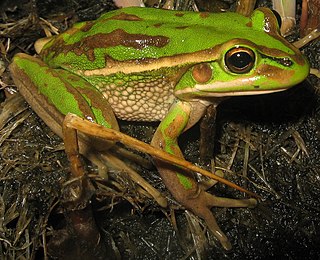
Ranoidea is a genus of frogs in the subfamily Pelodryadinae. They are found in Australia, New Guinea, and two nearby groups of islands: Maluku Islands (=Moluccas) and Louisiade Archipelago. The circumscription of this taxon is still controversial.
